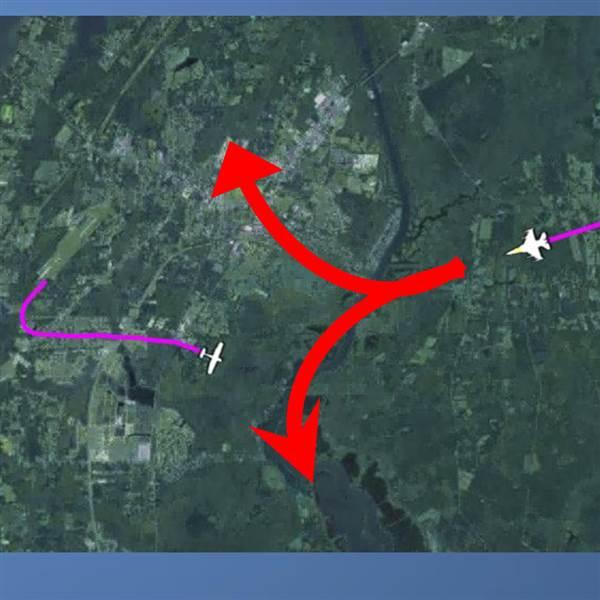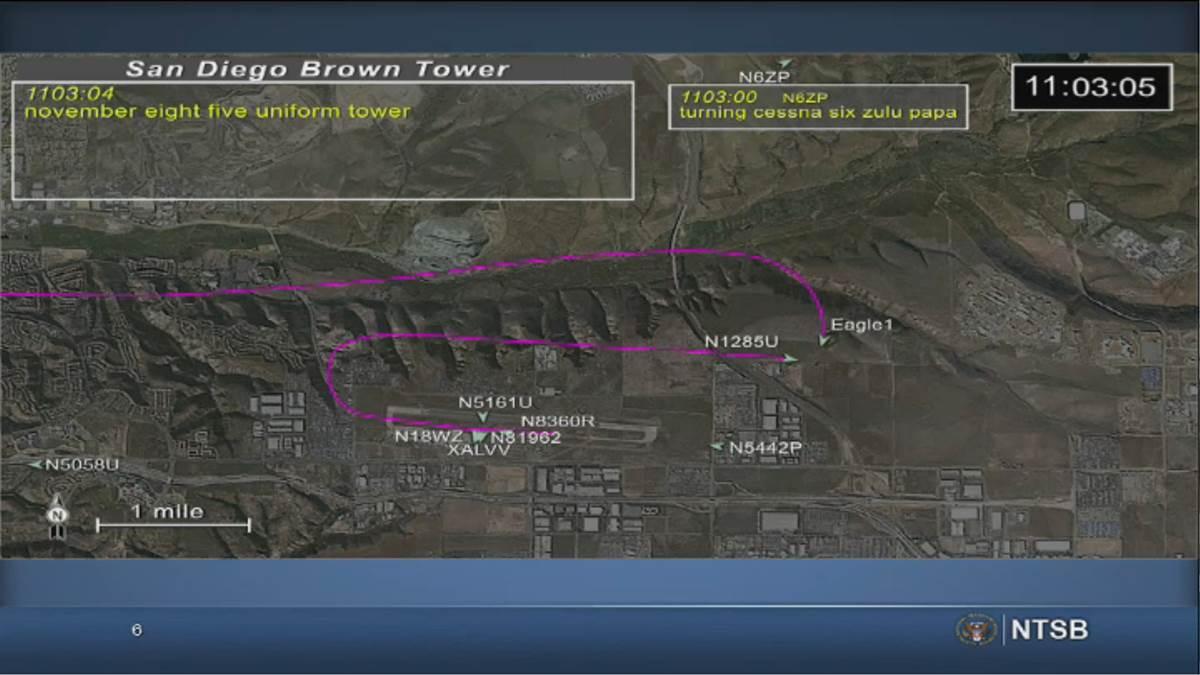NTSB calls for training after midairs
Investigations of two midair collisions about six weeks apart in 2015 led the NTSB to conclude air traffic controllers erred in both cases. While the safety agency urged the FAA and contract tower operators to use the deadly crashes as object lessons with which to train controllers, the NTSB did not specifically ask the FAA (or others) to address availability or affordability of cockpit traffic awareness technology that, according to both investigations, might have helped pilots prevent each tragedy. The safety recommendations and findings released Nov. 15 include advice for pilots.
Board members were absent Nov. 15 as lead investigators detailed the facts, circumstances, and findings of probable cause for two incidents: the July 7, 2015, collision between a Cessna 150 and a U.S. Air Force F-16, and the Aug. 16, 2015, traffic pattern collision involving a Sabreliner jet and a Cessna 172.
In the August 2015 incident, the Sabreliner with a defense contractor crew was cleared to land at Brown Field Municipal Airport in San Diego after the tower controller confused the call sign of a Skyhawk on the same downwind leg with another nearby Cessna. The tower controller (who had been supervising a trainee and took over minutes before the accident) used the wrong call sign to address the Cessna on downwind, then failed to verify that the Cessna had, in fact, begun the 360-degree turn as the controller expected.
In both cases, investigators found the pilots had little chance of seeing the oncoming traffic.
 In the Moncks Corner collision, both the Cessna pilot’s and the F-16 pilot’s view of each other was obstructed, according to an NTSB reconstruction based on radar and other data. In the San Diego tragedy, the Sabreliner crew reported multiple aircraft in sight to their left and right, but the crew could not see the Cessna 172 on the downwind leg just to their right. The light jet turned base and flew directly into the downwind Cessna. The NTSB created digital reconstructions of each accident from the pilot’s perspective, and overlaid information those pilots could have been provided by a traffic display, which was notably unavailable to any of the crews involved.
In the Moncks Corner collision, both the Cessna pilot’s and the F-16 pilot’s view of each other was obstructed, according to an NTSB reconstruction based on radar and other data. In the San Diego tragedy, the Sabreliner crew reported multiple aircraft in sight to their left and right, but the crew could not see the Cessna 172 on the downwind leg just to their right. The light jet turned base and flew directly into the downwind Cessna. The NTSB created digital reconstructions of each accident from the pilot’s perspective, and overlaid information those pilots could have been provided by a traffic display, which was notably unavailable to any of the crews involved.
The NTSB urged pilots to recognize the benefits of traffic awareness technology that can provide vital information about where to look. Such information can help pilots determine the best course of action to avoid even an unseen aircraft without requiring abrupt evasive maneuvers, or risking far worse. After the NTSB opened the public docket on the Moncks Corner crash Oct. 31, AOPA Air Safety Institute Senior Vice President George Perry noted that the limitations of see and avoid are well-known, and the Moncks Corner crash led to a renewed push to make Automatic Dependent Surveillance-Broadcast (ADS-B) traffic information available to all:
“In August 2015, AOPA asked the FAA to make ADS-B based traffic information available to all general aviation pilots. Currently, the ADS-B system only provides partial and incomplete traffic information to most general aviation aircraft that lack a certified ADS-B system,” Perry said after details of the Moncks Corner crash were made public. “We are getting close to a decision by the FAA to make this change, and are hopeful that soon pilots with low-cost, portable receivers will have a more complete picture of the traffic around them. Once this change is implemented it will save lives and help pilots prevent this type of accident from happening in the future.”
In the meantime, Perry noted, the Air Safety Institute encourages pilots to equip with ADS-B In and Out when able, and add the extra level of safety this technology provides.
Cockpit traffic information displays could have called the attention of the F-16 and the Cessna 150 pilots to each other’s presence while they were still 15 miles apart, noted lead investigator Dennis Diaz in his Nov. 15 presentation. The approach controller, who received an alert from the radar system, was providing radar services to the F-16 pilot who was making a practice approach. The approach controller assumed the Cessna (which was broadcasting its altitude via transponder, but not in radio contact), still low but climbing when picked up by radar, would remain in the local traffic pattern, not continue east, climbing into the path of the F-16.
This assumption led the controller to instruct the F-16 to turn left “immediately” to a 180 heading if the traffic was not in sight. The F-16 pilot did not understand the urgency, as the pilot and controller interpreted the word “immediately” in different ways based on their training and experience. Rather than expedite the turn, the pilot used the autopilot to begin a standard-rate turn while scanning the skies for a Cessna that was, by then, blocked from view by the fighter’s instrument panel. The controller, Diaz said, expected the F-16 to execute a high-performance turn.
Diaz said the controller could have directed a right turn had she understood the situation better.
“Her attempt at establishing visual separation at so close a range and with the airplanes approaching at such high speed left few options,” Diaz said, noting that the instruction to turn left rather than right, and the controller’s reliance on the F-16 pilot to see and avoid the Cessna, proved disastrous. “Although this decision was not contrary to FAA guidance, it was the least conservative decision.”

The tower controller in San Diego had a complex problem to tackle, with nine aircraft operating and a single controller handling both air and ground traffic. A trainee controller was handling communications until about three minutes before the collision, lead investigator Andrew Swick noted during his Nov. 15 presentation. The supervising controller who took over control duties missed opportunities while attempting to handle a situation that exceeded the supervising controller’s personal workload limit.
The Sabreliner and the Cessna 172 were both on a right downwind, with the Cessna closer to the runway, as the controller called out to the wrong Cessna to execute the 360-degree turn. The controller then issued a landing clearance to the Sabreliner without verifying that the Cessna he thought he had instructed to make the turn was, in fact, complying. Seconds later, the Sabreliner turned right onto the base leg and struck the Skyhawk. Recorded radio transmissions and radar data make clear in hindsight the dangerous situation neither pilot nor controllers were aware of. As with the South Carolina collision, traffic displays in one or both cockpits might have given the pilots enough information to prevent catastrophe.
Swick said other errors by the local controller included failure to issue a safety alert to the Sabreliner, and failure to recognize alternatives, such as directing aircraft away from the airport to reduce workload, or designating the trainee to act as ground controller when the traffic volume exceeded the controller’s personal workload limits.
Both statements of probable cause specifically reference limitations to see-and-avoid, relied on as the primary means of collision avoidance under VFR since rules were established. Those limitations include human ability to process visual information, competition for pilot attention from other tasks, and the environment. Each of these limitations can be compensated for, to a significant degree if not completely, by a relatively simple cockpit display, the NTSB noted.
AOPA has been a vocal advocate of regulatory reform that streamlines certification and makes it easier for owners to add non-required safety enhancing equipment (NORSEE). That includes creating a more efficient pathway to installation of a variety of new technologies into a fleet dominated by legacy aircraft: engine and fuel monitoring systems, displays that provide angle of attack as well as traffic and weather information, autopilots, and other equipment that enhances safety.
The NTSB has once again included general aviation specifically in its Most Wanted list of safety improvements despite a long pattern of declining accident and fatality rates. Nearly half of GA accidents are tied to loss of control; here again, technology such as angle of attack indicators and improved situational awareness can help improve safety. The NTSB reserved its own advocacy for collision warming systems for the highways and railroads on the latest Most Wanted list. This may be a reflection of the fact that midair collisions are rare, with about half a dozen or fewer in a typical year according to Air Safety Institute records.
The NTSB issued two safety recommendations Nov. 15 tied to the Moncks Corner and Sand Diego crashes, calling on the FAA and contract tower operators to include the lessons learned in initial and recurrent training and to brief all controllers and supervisors on the details of both of these incidents, and the subsequent findings.
A previous safety recommendation was issued in 2010 following a 2009 collision between a tour helicopter and a Piper PA-32 in the busy Hudson River Corridor. Six years before the Moncks Corner or San Diego collisions, the NTSB called on the FAA to update advisory circulars to reflect current airspace descriptions, references to high-volume traffic environments, and “the use of electronic traffic advisory systems for pilots operating under the see-and-avoid concept.”




